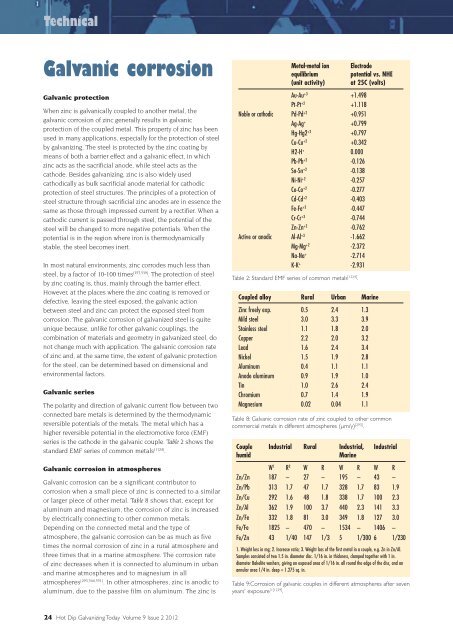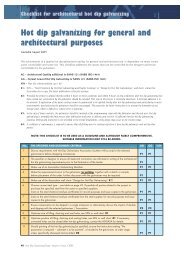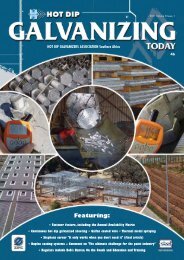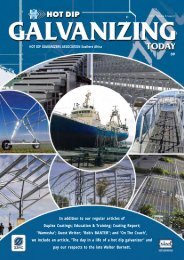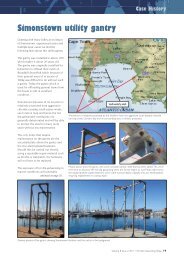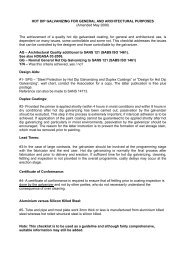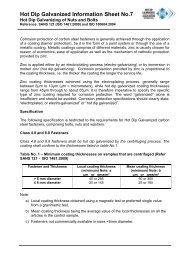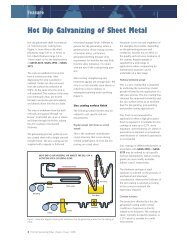Download - hdgasa
Download - hdgasa
Download - hdgasa
You also want an ePaper? Increase the reach of your titles
YUMPU automatically turns print PDFs into web optimized ePapers that Google loves.
Technical<br />
Galvanic corrosion<br />
Galvanic protection<br />
When zinc is galvanically coupled to another metal, the<br />
galvanic corrosion of zinc generally results in galvanic<br />
protection of the coupled metal. This property of zinc has been<br />
used in many applications, especially for the protection of steel<br />
by galvanizing. The steel is protected by the zinc coating by<br />
means of both a barrier effect and a galvanic effect, in which<br />
zinc acts as the sacrificial anode, while steel acts as the<br />
cathode. Besides galvanizing, zinc is also widely used<br />
cathodically as bulk sacrificial anode material for cathodic<br />
protection of steel structures. The principles of a protection of<br />
steel structure through sacrificial zinc anodes are in essence the<br />
same as those through impressed current by a rectifier. When a<br />
cathodic current is passed through steel, the potential of the<br />
steel will be changed to more negative potentials. When the<br />
potential is in the region where iron is thermodynamically<br />
stable, the steel becomes inert.<br />
In most natural environments, zinc corrodes much less than<br />
steel, by a factor of 10-100 times [357,539] . The protection of steel<br />
by zinc coating is, thus, mainly through the barrier effect.<br />
However, at the places where the zinc coating is removed or<br />
defective, leaving the steel exposed, the galvanic action<br />
between steel and zinc can protect the exposed steel from<br />
corrosion. The galvanic corrosion of galvanized steel is quite<br />
unique because, unlike for other galvanic couplings, the<br />
combination of materials and geometry in galvanized steel, do<br />
not change much with application. The galvanic corrosion rate<br />
of zinc and, at the same time, the extent of galvanic protection<br />
for the steel, can be determined based on dimensional and<br />
environmental factors.<br />
Galvanic series<br />
The polarity and direction of galvanic current flow between two<br />
connected bare metals is determined by the thermodynamic<br />
reversible potentials of the metals. The metal which has a<br />
higher reversible potential in the electromotive force (EMF)<br />
series is the cathode in the galvanic couple. Table 2 shows the<br />
standard EMF series of common metals [1124] .<br />
Galvanic corrosion in atmospheres<br />
Galvanic corrosion can be a significant contributor to<br />
corrosion when a small piece of zinc is connected to a similar<br />
or larger piece of other metal. Table 8 shows that, except for<br />
aluminum and magnesium, the corrosion of zinc is increased<br />
by electrically connecting to other common metals.<br />
Depending on the connected metal and the type of<br />
atmosphere, the galvanic corrosion can be as much as five<br />
times the normal corrosion of zinc in a rural atmosphere and<br />
three times that in a marine atmosphere. The corrosion rate<br />
of zinc decreases when it is connected to aluminum in urban<br />
and marine atmospheres and to magnesium in all<br />
atmospheres [293,544,551] . In other atmospheres, zinc is anodic to<br />
aluminum, due to the passive film on aluminum. The zinc is<br />
Metal-metal ion Electrode<br />
equilibrium potential vs. NHE<br />
(unit activity) at 25C (volts)<br />
Au-Au +3 +1.498<br />
Pt-Pt +2 +1.118<br />
Noble or cathodic Pd-Pd +2 +0.951<br />
Ag-Ag + +0.799<br />
Hg-Hg2 +2 +0.797<br />
Cu-Cu +2 +0.342<br />
H2-H + 0.000<br />
Pb-Pb +2 -0.126<br />
Sn-Sn +2 -0.138<br />
Ni-Ni +2 -0.257<br />
Co-Co +2 -0.277<br />
Cd-Cd +2 -0.403<br />
Fe-Fe +2 -0.447<br />
Cr-Cr +3 -0.744<br />
Zn-Zn +2 -0.762<br />
Active or anodic Al-Al +3 -1.662<br />
Mg-Mg +2 -2.372<br />
Na-Na + -2.714<br />
K-K + -2.931<br />
Table 2: Standard EMF series of common metals [1224] .<br />
Coupled alloy Rural Urban Marine<br />
Zinc freely exp. 0.5 2.4 1.3<br />
Mild steel 3.0 3.3 3.9<br />
Stainless steel 1.1 1.8 2.0<br />
Copper 2.2 2.0 3.2<br />
Lead 1.6 2.4 3.4<br />
Nickel 1.5 1.9 2.8<br />
Aluminum 0.4 1.1 1.1<br />
Anode aluminum 0.9 1.9 1.0<br />
Tin 1.0 2.6 2.4<br />
Chromium 0.7 1.4 1.9<br />
Magnesium 0.02 0.04 1.1<br />
Table 8: Galvanic corrosion rate of zinc coupled to other common<br />
commercial metals in different atmospheres (μm/y) [293] .<br />
Couple Industrial Rural Industrial, Industrial<br />
humid<br />
Marine<br />
W 1 R 2 W R W R W R<br />
Zn/Zn 187 – 27 – 195 – 43 –<br />
Zn/Pb 313 1.7 47 1.7 328 1.7 83 1.9<br />
Zn/Cu 292 1.6 48 1.8 338 1.7 100 2.3<br />
Zn/Al 362 1.9 100 3.7 440 2.3 141 3.3<br />
Zn/Fe 332 1.8 81 3.0 349 1.8 127 3.0<br />
Fe/Fe 1825 – 470 – 1534 – 1406 –<br />
Fe/Zn 43 1/40 147 1/3 5 1/300 6 1/230<br />
1. Weight loss in mg; 2. Increase ratio; 3. Weight loss of the first metal in a couple, e.g. Zn in Zn/Al.<br />
Samples consisted of two 1.5 in. diameter disc. 1/16 in. in thickness, clamped together with 1 in.<br />
diameter Bakelite washers, giving an exposed area of 1/16 in. all round the edge of the disc, and an<br />
annular area 1/4 in. deep = 1.275 sq. in.<br />
Table 9:Corrosion of galvanic couples in different atmospheres after seven<br />
years' exposure 3 [1229] .<br />
24 Hot Dip Galvanizing Today Volume 9 Issue 2 2012


